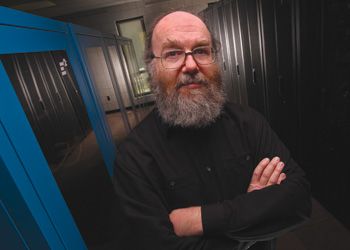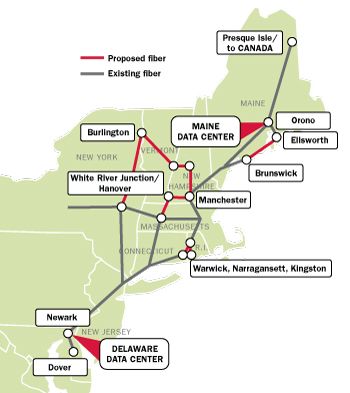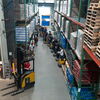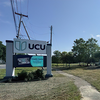Booting up | UMaine constructs a high-powered supercomputer with private sector customers in mind
A cluster of 700 computers hums away inside a classroom building at the University of Maine in Orono. Students pass by, oblivious to the machines’ presence or to what, together, the computers can accomplish. Despite lacking special components or expensive price tags, the off-the-shelf computers are capable of cranking out trillions of computations per second, whizzing through complex calculations leagues faster than the average desktop computer. Individually, the computers aren’t all that different from the ones for sale in a typical electronics store. But these computers are tied together, functioning as a single, souped-up unit of processing power called a supercomputer.
And while it’s housed at UMaine, the supercomputer’s capabilities extend far beyond the university or even researchers in general. Businesses can also access the machine, sending their computing jobs to UMaine for a quick turnaround and thereby freeing up their in-house computers or, better yet, circumventing significant investment in their own machines in the first place. Bath Iron Works, for example, could run a simulation showing how different hull designs affect the stability of a Navy ship. Or a small marketing firm could create graphic renderings of various redevelopment options for a vacant paper mill to show to clients. All of it happens faster and cheaper than the companies could manage alone.
But for now, this supercomputing scenario exists in concept only. It’s one piece of a broader vision for expanding Maine’s cyberinfrastructure, aiding not only existing Maine businesses but ideally providing a competitive advantage to attract new ones, as well as helping train more information technology professionals in the state. Led by the University of Maine System, the initiative, known as CIDER — Cyberinfrastructure Investment for Development, Economic Growth and Research — was recently awarded $250,000 by the Maine Technology Institute to purchase the supercomputer’s foundational machines. The project will launch with 500 to 700 machines, but hopes are that it will grow to multiple thousands of computers.
And complex computing is only half of the equation. The project’s backers also see the supercomputer performing as a cloud resource, or a central hub where companies’ applications and data could live, completely separate from the physical computing hardware in their offices. “It doesn’t have to be the next rocket engine,” says Bruce Segee, the project’s director and an associate professor of electrical and computer engineering at UMaine. “We’re talking about a computer’s server, e-mail, word processor.” Employees could work from anywhere, without being tethered to a clunky desktop, using a simple Web browser to access the information housed in Orono. Meanwhile, nightly information backups and regular software updates occur without interfering with companies’ day-to-day business. “It’s just as though it’s on your desktop except you don’t have to pay someone to update your machine,” Segee says.
A novel idea, but first the project’s supporters have to convince private businesses of the supercomputer’s reliability and cost-saving potential. And for Maine to become a high-tech computing center, many related efforts — including the expansion of fiber optic networks and fostering a significant skilled IT work force — must work in tandem.
Components of a whole
Bruce Segee sits with Jeff Letourneau, executive director the University of Maine System’s Networkmaine organization, at a Starbucks in UMaine’s student center. The two men couldn’t look any more different. Wearing a red polo shirt with a university logo, Segee looks the part of a professor who has co-authored a graduate-level textbook on microprogramming and computer architecture, with his wild gray beard and square glasses. Letourneau, on the other hand, clean cut and wearing a blue button-down shirt with khaki pants, looks like a man who appreciates the order of systems. As head of Networkmaine, a unit of the university system, he oversees the management of a regional network that provides Internet services to not only the seven universities but also to K-12 schools, libraries, state government and nonprofits.
Despite their contrasting appearances, Segee and Letourneau are working toward a common goal, one they’ll pitch to Maine’s private sector this fall. By signing on to use UMaine’s supercomputer, Maine businesses will help expand and refresh a computing resource that could in turn attract more business to Maine, the men say. The pitch: A company could purchase individual “nodes” to add on to the supercomputer, basically modular building blocks that would be available to the company at any time. Say a business buys 10 nodes; all 10 would be at its disposal for typical operations, but another 20, 50, 100 or more could also be tapped into for periodic jobs requiring more computing power. The business avoids buying additional computers to handle occasional work, as well as the costs for heating and cooling the temperature-sensitive machines and hiring techs to service them.
“It makes less and less sense to have all of these businesses doing essentially the same thing that’s not their core business,” Segee says. Freed of IT overhead, businesses can better compete, he says. “It makes a small business almost feel like or be able to act like a much larger corporation.” Still, fear of the unknown will no doubt present a challenge in winning some companies over as marketing efforts begin in a few months, he acknowledges. “I think there’s going to be a lot of reluctance from companies that have large IT staffs,” Segee says.
The supercomputer is just one piece of a wider effort to make Maine a center for high-performance computing. Businesses with complex computing requirements often rent out space to accommodate their systems, or turn to out-of-state data centers in metropolitan areas, where real estate is expensive and rates are high, the men explain. But Maine has a distinct advantage as a potential home for the supercomputers and disaster recovery systems that data centers house: paper mills.
Power represents roughly 90% of the cost of operating a data center. By sharing space with a mill, a center could run on the affordable, reliable power generated by the mill through hydropower and biomass. That would also serve as a boon for the mill, which could sell the power to the center free of any distribution costs. Plus paper mills are located in rural areas, perfect for computing warehouses that most of their customers never visit, and cold Maine river water is ideal for cooling the centers.
Old Town Fuel and Fiber has been eyed for a center that could serve an array of industries, including aquaculture, composite manufacturing and agriculture. Letourneau envisions it as just one of many data centers in Maine. “It’s turning the data flow around,” he says. “Rather than Maine being the consumer of services everywhere else in the world, have the world [be] the consumer of services in Maine.” For now, even one data center would help to maximize the tens of millions of dollars in private and public investment Maine has already made in its fiber optic network, including the $25 million Three Ring Binder project that will add 1,100 miles of broadband network to the state’s rural areas. Five states are also working to expand Internet accessibility and capability through the North East Cyberinfrastructure Consortium. If the data center industry takes off here, UMaine would be glad to hand over the reins to the private sector one day, Letourneau says. “The whole driver here is economic development,” he says. “It’s not just for the propeller heads to crunch numbers.”
Jackie Farwell, Mainebiz senior writer, can be reached at jfarwell@mainebiz.biz.










Comments